Types of Appliances

TRANSPALATAL BAR / NANCE / LINGUAL ARCH
The transpalatal bar / Nance / lingual arch appliances are used in the upper and lower arches to maintain space. Primarily, they are placed in patients who are in transitional dentition (not all adult teeth have erupted), to hold space in the arch for the permanent teeth to erupt. In cases where it is appropriate to use this appliance, it will be part of the beginning phase of orthodontic treatment.

The transpalatal bar / Nance is a metal bar attached to the tongue side of the upper first molar bands, and form-fitted along the roof of the mouth, and it may or may not have acrylic. The transpalatal bar helps to maintain the width of the dental arch. We commonly use this appliance for patients who have an impacted permanent tooth, and exposure of that tooth is suggested.

The lingual arch is a metal bar that is attached to the tongue side of the lower first molar bands, and form-fitted behind the teeth. This appliance is recommended when baby teeth are lost prematurely, so the space may be maintained.

The biteplane is an appliance used to reduce a deep overbite, whereby the upper front teeth overlap the lower front teeth excessively. It works by preventing the patient from biting down all the way on his or her back teeth. This allows the back teeth to emerge naturally, which reduces the overlap of the front teeth. The bite plane is made of wire and acrylic, which can be removable or cemented in place by an orthodontist. The removable bite plane is most effective when worn all the time. The quality of our end result and completing treatment on time is dependent upon the patient wearing the bite plane consistently.
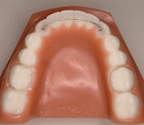
FIXED LINGUAL RETAINER
Fixed lingual retainers are wires bonded behind the upper and/or lower front teeth, on the day the braces are removed. The lower wire is bonded in place to stabilize the lower front teeth during the retention phase of treatment. This wire remains in the mouth for at least two years, but ideally should remain as long as the patient is able to keep the back side of the lower front teeth clean.
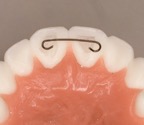
When a fixed retainer is used in the upper arch, it is usually behind the two upper front teeth. This is typically used for patients who had a large space between the front teeth before orthodontic treatment. The upper fixed lingual retainer should remain in place for as long as possible, or until your general dentist recommends it be removed.

Forsus springs are used in cases where the upper teeth are forward of the proper fit with the lower teeth. They have almost the same effect as rubber bands and are primarily used when patients have proven to be uncooperative with rubber band and/or headgear wear. They are NOT a substitute for headgear though. If headgear wear is poor, then Forsus springs may offer an acceptable compromise. Forsus springs are used as a second resort because rubber bands are usually more comfortable to wear and allow for easier brushing. Forsus springs are used in conjunction with upper and lower braces and are placed by an orthodontist. They are held in place by tubes on the upper molars and attached to the lower archwire. The springs work EXTREMELY well because they are not removable and ensure a constant force on the teeth.
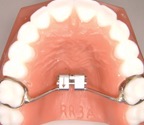
In the field of orthodontics, no appliance is more effective at expanding the maxillary (upper) arch. A palatal expander is our first choice for patients who require an increase in the width of the upper dental arch. This not only corrects crossbites, but it creates needed space when there is crowding. Palate expanders use two or four teeth to anchor themselves in place, and by turning a small screw we are able to achieve expansion of the upper jaw by as much as 3/4 of an inch! The goal of the appliance is not just to move the teeth apart, but also to move the bones of the palate apart. Since a palate expander is primarily an orthopedic appliance (influencing the growth of bone), the younger the patient’s age when it is used, the more rapid and more stable the correction. When a patient reaches the stage we call skeletal maturity (approximately age 16 for girls and for boys around the age of 18), the two bones that comprise the upper jaw fuse, and expansion through orthopedics is extremely difficult without surgical assistance.
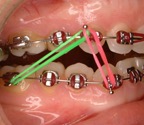
RUBBER BANDS
Rubber bands are the primary mechanism we use to move teeth so they fit together correctly top to bottom. They can be worn in any number of configurations. Rubber bands are attached using hooks that are part of the brackets or the bands. Always remember that braces merely give us a way to “grab onto” the teeth. It is the rubber bands and wires that move the teeth. The rubber band phase of treatment is the one that takes the longest in the average patient. Please keep in mind that the rubber bands only move teeth; however, if you have any discomfort in your jaw joint, please let us know. The quality of our end result and completing treatment on time is dependent upon the patient following instructions for wearing rubber bands precisely. In most instants, this means all the time. For those who seek maximum aesthetics, we have tooth-colored rubber bands. For those who want to make a fashion statement, we have fun colors.

SEPARATORS
Separators are small rubber or metal rings that are placed between the contacts of the teeth. Their purpose is to create space between the teeth to allow for the placement of bands on the molar teeth. The separators are placed five to ten days prior to the start appointment. Initially, they may cause some minor discomfort. Patients sometimes say it feels like a piece of meat stuck between their teeth. During this period, we ask the patient to avoid sticky or chewy foods to prevent them from becoming dislodged. You will need to check them periodically, and if they fall out, please contact our office to determine if they will need to be replaced.
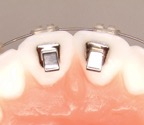
TURBO BRACKETS
Turbo brackets are appliances used to reduce a deep overbite, whereby the upper front teeth overlap the lower front teeth excessively. These appliances work by preventing the patient from biting down all the way on his/her back teeth; this allows the back teeth to emerge naturally, thus reducing the overlap of the front teeth. The turbo brackets are small metal brackets cemented behind the two upper front teeth. They are extremely effective because they cannot be removed. However, they may cause difficulty during eating, at first. We recommend eating soft foods during this transition, and expect your back teeth to come together over the course of a few months.
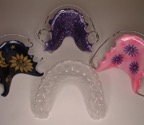
RETAINERS (REMOVABLE)
The slip cover or Essix retainer (clear plastic) is the first initial retainer that most patients receive on the day the braces are removed. These retainers effectively maintain the alignment of teeth, while simultaneously allowing for controlled, minute movement of teeth which orthodontists call “settling.” When worn as instructed, the bite actually improves in the critical first few weeks after the braces are removed. Retainers are truly as important as braces in the long-term result of orthodontic treatment. And YES, retention is a lifelong commitment. Shifting and crowding of the teeth have been shown to be part of the normal aging process. Your retainers allow you to keep your youthful smile long after nature intended. Please follow our use, care, and maintenance instructions carefully. We will advise you of any special instructions for your particular case.